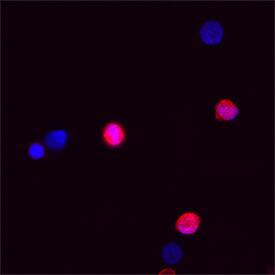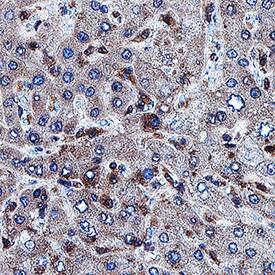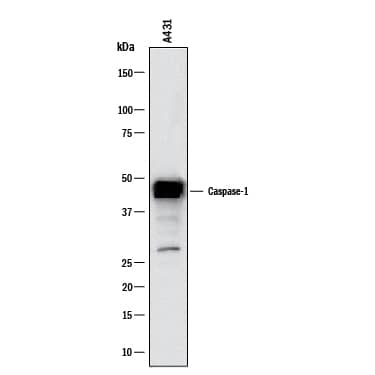Human Caspase-1 Antibody
R&D Systems, part of Bio-Techne | Catalog # MAB62156

Key Product Details
Species Reactivity
Applications
Label
Antibody Source
Product Specifications
Immunogen
Asn120-Asp297
Accession # P29466
Specificity
Clonality
Host
Isotype
Scientific Data Images for Human Caspase-1 Antibody
Detection of Human Caspase-1 by Western Blot.
Western blot shows lysates of A431 human epithelial carcinoma cell line. PVDF membrane was probed with 2 µg/mL of Rabbit Anti-Human Caspase-1 Monoclonal Antibody (Catalog # MAB62156) followed by HRP-conjugated Anti-Rabbit IgG Secondary Antibody (HAF008). A specific band was detected for Caspase-1 at approximately 48 kDa (as indicated). This experiment was conducted under reducing conditions and using Western Blot Buffer Group 1.Caspase-1 in PC-3 Human Cell Line.
Caspase-1 was detected in immersion fixed PC-3 human prostate cancer cell line (positive staining) and U937 human histiocytic lymphoma cell line (negative control) using Rabbit Anti-Human Caspase-1 Monoclonal Antibody (Catalog # MAB62156) at 8 µg/mL for 3 hours at room temperature. Cells were stained using the NorthernLights™ 557-conjugated Anti-Rabbit IgG Secondary Antibody (red; NL004) and counterstained with DAPI (blue). Specific staining was localized to cell nuclei and cytoplasm. Staining was performed using our protocol for Fluorescent ICC Staining of Non-adherent Cells.Caspase-1 in Human Lymph Node.
Caspase-1 was detected in immersion fixed paraffin-embedded sections of human lymph node using Rabbit Anti-Human Caspase-1 Monoclonal Antibody (Catalog # MAB62156) at 3 µg/mL for 1 hour at room temperature followed by incubation with the Anti-Rabbit IgG VisUCyte™ HRP Polymer Antibody (VC003). Before incubation with the primary antibody, tissue was subjected to heat-induced epitope retrieval using Antigen Retrieval Reagent-Basic (CTS013). Tissue was stained using DAB (brown) and counterstained with hematoxylin (blue). Specific staining was localized to cytoplasm in Kupffer cells. Staining was performed using our protocol for IHC Staining with VisUCyte HRP Polymer Detection Reagents.Applications for Human Caspase-1 Antibody
Immunocytochemistry
Sample: Immersion fixed PC-3 human prostate cancer cell line
Immunohistochemistry
Sample: Immersion fixed paraffin-embedded sections of human lymph node
Western Blot
Sample: A431 human epithelial carcinoma cell line
Formulation, Preparation, and Storage
Purification
Reconstitution
Formulation
Shipping
Stability & Storage
- 12 months from date of receipt, -20 to -70 °C as supplied.
- 1 month, 2 to 8 °C under sterile conditions after reconstitution.
- 6 months, -20 to -70 °C under sterile conditions after reconstitution.
Background: Caspase-1
Caspase-1, also known as IL-1 beta-Converting Enzyme (ICE), is an aspartic protease that plays a key role in the inflammatory response and apoptosis. Caspase-1 precursor (about 50kDa) can be cleaved and the active enzyme consists of a complex of two 20 kDa (aa 120-297) and two 10 kDa (aa 317-404) subunits which associate following cleavage of inactive precursors. Caspase-1 is required for proteolytic cleavage of the IL-1 beta precursor to form the active proinflammatory cytokine. Alternate splicing generates several additional Caspase-1 isoforms with deletions in the propeptide regions or also in the mature subunits. Within the large subunit, human Caspase 1 shares 61% aa sequence identity with mouse and rat Caspase-1.
Additional Caspase-1 Products
Product Documents for Human Caspase-1 Antibody
Product Specific Notices for Human Caspase-1 Antibody
For research use only


